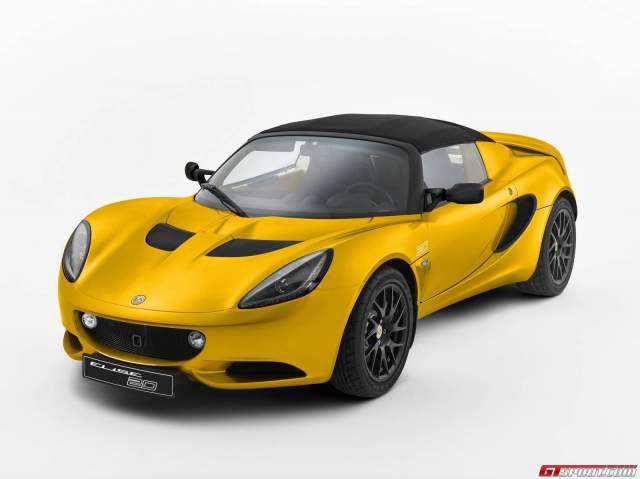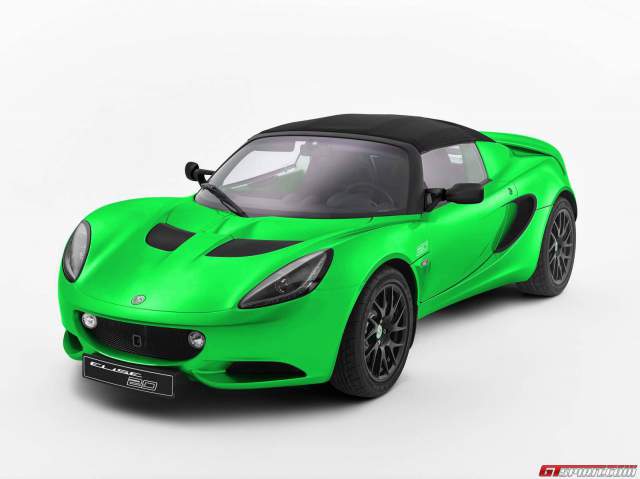To help celebrate the 20th anniversary of the iconic Lotus Elise, the British marque has taken the wraps off the special Lotus Elise S 20th Anniversary Special Edition. The commemorative Elise replaces the Elise S Club Racer in the Lotus line-up and includes a number of subtle tweaks over existing Elise variants.
Interestingly, the Lotus Elise S 20th Anniversary Special Edition weighs 10 kg less than the Elise S thanks to some minor weight saving measures including the fitment of lightweight forged wheels. Powering the Elise 20th Anniversary Special Edition is a 1.8-litre supercharged four-cylinder engine helping to send the 914 kg sports car to 100 km/h in a brisk 4.6 seconds as well as a top speed of 237 km/h. Despite the potent performance the car offers, it only sips 5.9 litres of petrol per 100 km while emitting 173 grams of CO2 per km.
Returning to the weight saving employed by the Elise, it also includes a lighter centre console as well as brand new sports seats finished in either leather or alcantara. Another new inclusion for the 20th Anniversary Special Edition is a new sport mode which has been designed to improve the throttle response while also altering the traction slip thresholds.
The car is then available in four colours; blue, green, yellow and silver with the rear diffuser, wing mirrors and roll hoops painted in matte black. The British marque claims that all the improvements employed on the Elise S 20th Anniversary Special Edition amount to 5150 euros but pricing only sits 2700 euros above the Elise S. As a result, it will set customers back a minimum of 39,900 euros.
Discussing the car, chief executive of Lotus Jean-March Gales said, “It is sometimes hard to believe that the Elise has been around for 20 years. It was ground breaking when it was launched and continues to be the benchmark for handling and performance in its class. Over the years we have improved and refined the Elise but we have also ensured that we have retained the purity of the driving experience and for the Elise to remain as the sports car to which other marques aspire.”
[showhide]
“The Lotus Elise 20th Anniversary Special Edition celebrates the unveiling of the iconic sports car at the Frankfurt Motor Show in September 1995.
20 years ago, the Lotus Elise revolutionised the sports car world, setting the benchmark for handling, purity of the driving experience, lightweight and efficiency. Its pioneering and advanced bonded aluminium chassis was a market-leading technological innovation at the time and over the years has improved and evolved and remains core to the Elise’s exceptional performance today.
Jean-Marc Gales, CEO of Group Lotus plc, welcomes the Elise 20th Anniversary model, “It is sometimes hard to believe that the Elise has been around for 20 years. It was ground breaking when it was launched and continues to be the benchmark for handling and performance in its class. Over the years we have improved and refined the Elise but we have also ensured that we have retained the purity of the driving experience and for the Elise to remain as the sports car to which other marques aspire.”
The Elise 20th Anniversary, with its lightweight aero-optimised, composite body, is powered by a 1.8-litre supercharged engine. It reaches 0-62 mph (0-100 km/h) in 4.6 seconds and has a top speed of 145 mph (237 km/h). The benefit of this light weight is that the Elise 20th Anniversary consumes just 5.9 litres / 100 km (47.6 mpg) extra urban and emits just 173 g of CO2 per km.
Weighing just 914 kg, 10 kg less than the Elise S, the Elise 20th Anniversary is the sports car that both enthusiasts and newcomers to the brand will desire. Lightweight, efficient and totally pure in its driving experience, its benchmark in handling remains the envy of the sports car scene. Additional equipment compared to the Elise S comes as standard and is designed to reduce weight, including lightweight matt black forged wheels, lightweight centre console in body colour and lightweight sports seats in leather or Alcantara with colour coded stitching. A sport mode is also included which increases throttle response and alters the traction slip thresholds allowing the driver enhanced control before intervention.
Four classic Elise colours are available in Blue, Green, Yellow and Silver and the rear diffuser, wing mirrors, roll hoop cover and rear transom are in matt black. Elise 20th Anniversary decals inside on the dashboard and seats and outside above the side indicator identify the anniversary special edition.
All this additional equipment amounts to £5,150 worth of extra value, for only £2,700 more than the standard Elise S (£37,200) and the Elise 20th Anniversary will become a driving investment for the future.
The Elise is the most successful Lotus model in terms of numbers built, with a total of almost 32,000 built and sold globally. In addition to the Elise, the Lotus small platform technology has been used to great success in the Lotus Exige, Lotus Europa and Lotus 2-Eleven models, all of which are, or have been manufactured by Lotus at its Headquarters in Hethel, Norfolk.
The Lotus Elise 20th Anniversary is on sale now with an MSRP of £39,900. It replaces the Elise S Club Racer. For other currency prices, please contact the Lotus press office. Orders can be placed now.
Specifications:
Each 20th Anniversary Lotus Elise Edition will have the following as standard:
* Body colour, lighter weight interior centre console
* Leather, or Alcantara (no cost), lighter sports seat trim option
* Colour-coded stitching on seats and door cards
* Colour-coded seat hoops
* Matt Black forged alloy wheels
* Matt Black distinguishing exterior trim
* A choice of four exterior colours – Classic Blue / Green / Yellow / Silver
* Auxiliary driving lights
* Elise 20th Anniversary decals externally and on dashboard stereo blanking-plate
Options
Hardtop £1,200
Air Conditioning £1,250
CD/Radio and USB Connection and NVH Pack £1,200
Fuel consumption for Elise 20th Anniversary:
Urban 27.3 mpg – 10.3 litres / 100 km. Extra urban 47.6 mpg – 5.9 litres / 100 km.
Combined – 37.5 mpg – 7.5 litres / 100 km. CO2 emissions 173 g CO2 / km.
[/showhide]























